Table of Contents
Gudi Padwa: A Celebration of New Beginnings
Gudi Padwa marks the beginning of the Hindu New Year in Maharashtra. It is celebrated on the first day of Chaitra as per the lunar calendar. Families raise the 'Gudi,' a decorated bamboo stick with a silk cloth, neem leaves, and an inverted copper or silver pot. This ritual symbolizes victory, prosperity, and protection from negativity.
The festival has historical roots. It is believed that Lord Rama's return to Ayodhya and the coronation of Chhatrapati Shivaji Maharaj are associated with this day. The festival is a time for new beginnings, prayers, and festive attire.
What is a Nauvari Saree?
The Nauvari saree, meaning 'nine yards,' is a traditional attire Maharashtrian women wear. Unlike regular six-yard sarees, it does not require a petticoat. The draping style allows ease of movement, making it a preferred choice for celebrations and cultural performances.
The Nauvari saree is linked to Maharashtra's history. Women in the Maratha empire wore it for combat, signifying strength and resilience. It remains an integral part of festivals, weddings, and religious ceremonies today.
Significance of the Nauvari Saree in Maharashtrian Culture
The Nauvari saree is not just a garment; it represents tradition and cultural pride. It is worn in different draping styles based on region and occasion.
-
Brahmini Nauvari: Married women wore a pleated and tucked style during religious rituals.
-
Kashta Style: A warrior-like drape inspired by the Maratha era.
-
Peshwai Nauvari: A regal style that reflects the elegance of the Peshwa period.
The Nauvari saree holds religious significance. It is commonly worn during Ganesh Chaturthi, Navratri, and Gudi Padwa. The saree's fabric choice—silk, cotton, or Paithani—depends on the occasion.
How to Drape a Nauvari Saree
Draping a Nauvari saree may seem challenging, but with practice, it becomes effortless. Here's a step-by-step guide:
-
Tuck the Saree: Start by tucking one end of the saree at the back and bring it to the front.
-
Create the Kashta: Pass the fabric between the legs and tuck it at the back to form the dhoti-like look.
-
Make Pleats: Gather pleats in the front and tuck them at the waist.
-
Adjust the Pallu: Drape the remaining fabric over the shoulder like a regular saree.
-
Secure the Look: Pin the saree in place for a comfortable fit.
Pairing the Nauvari saree with the right accessories enhances the look.
Styling a Nauvari Saree for Gudi Padwa
-
Jewelry Selection
-
Wear a 'Nath' (nose ring) to highlight traditional aesthetics.
-
Layer a 'Thushi' necklace with a long 'Mohan Mala.'
-
Choose green glass bangles, as they symbolize prosperity.
-
Adorn the forehead with a 'Bindi' and ‘Maang Tikka.’
-
Hairstyle and Makeup
-
Style hair in a bun with jasmine flowers (Gajra).
-
Apply kohl to define the eyes and a bold lip color for contrast.
-
Use a minimal base to keep the focus on the saree and jewelry.
-
Footwear Choices
-
Traditional Kolhapuri chappals or mojaris enhance the ethnic look.
-
Choose heels only if they complement the saree drape.
-
Blouse Designs
-
Opt for a fitted blouse with conventional embroidery.
-
Sleeveless or full-sleeved blouses work well based on comfort and style preference.
Embracing Tradition with Modern Styling
The Nauvari saree is a timeless choice for Gudi Padwa. It connects the past with the present, making celebrations more meaningful. The saree represents cultural pride, whether paired with traditional jewelry or modern accessories.




